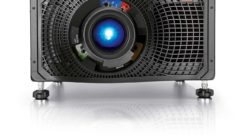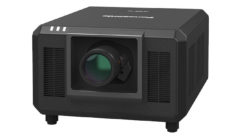CLEAR PROJECTIONS
Sep 1, 1998 12:00 PM,
M. K. Milliken Jr.
Fonts have been around for more than 500 years, ever since Herr Gutenberginvented movable type in 1437. And, as anyone who owns a computer knows,there are plenty of them to choose from. All fonts have faces, and allfaces belong to a family. Thus, this font appears here in its standardface, but there are also italic and bold as alternative and additionalfaces. To see the elements that distinguish one font from another, considerFigure 1. These are the principal parts of the characters and symbols whichmake up any font family. Note particularly the dimension marked as”x-height.” This term is printers’ language for the height of a character,excluding (if any) its ascender or descender. I suggest that the x-heightis also convenient for measuring the minimum height for any lowercasecharacter or symbol.
A property that does not belong to any given font family is size. Fonts,especially computer-generated ones, are scalable. We can describe theirprinted size by specifying the number of points a letter is to occupy.There are approximately 72 points to the inch (25.4 mm), and 12 of thesepoints are a pica. Precise as those measurements are, however, they are oflittle or no use when the font is not to be printed but projected.Approximately 1/12 inch (2.1 mm) high letters are fine for this page butwould be hopeless on a 100 inch 92.5 m) diagonal projection screen.
Some interesting things may be observed about the legibility of fonts ingeneral. One of them is that mixed case text is easier to read than TEXTWHICH IS PRINTED ALL IN CAPITAL LETTERS or even Text Which Has Just TheFirst Letter Of Every Word Capitalized. Another is that legibility dependson the tops of words. (See Figure 2.) Notice how much more difficult it isto decipher the lower half of the same sentence.
An enormously important attribute of fonts is whether any particular faceis serif or sans serif. Serifs are small, usually horizontal cross strokesthat are added to the ends of a letter’s main strokes. This type is serif,but typeface without serifs is sans serif. Because of their ability to coaxthe eye along the line of type, fonts with serifs are generallyacknowledged to be more readable.
Becoming sensitive to these observations is helpful, but it still doesn’treally answer, “How can we think about fonts for projected displays, andwhat guidelines can we follow for their manipulation?” Fortunately, thereare some valuable answers that emerge from research undertaken by Dr. JoyEbben of JME International in Alta Loma, CA. Dr. Ebben breaks the design ofprojected characters into five principal categories: shape, height-to-widthratio, pixel matrix, stroke width and character, and word and line spacing.With respect to the shape of the possibly ambiguous characters, she offerscase-sensitive criteria. A needs clearly delineated space above itshorizontal stroke. B needs approximately equal loops. C and G are easilyconfused with each other and with O if the C break is not clearlydiscernable or if the horizontal stroke of the G is not long enough. D andO can be confused if the O appears to square. E requires clearly delineatedspaces. M and W need sufficiently long center sections. P requires a largeenough loop. S and 5 are easily confused if the S is too square and/or thehorizontal top of 5 is not long enough. The number 1 and l must lookdifferent. U and V will be confused unless the uprightness of verticalstrokes of the U is maintained. Y needs a long tail to differentiate itfrom V, and it needs a distinctly v-shaped top to differentiate it from aT. The number 6 and 9 need apparent (but not too large) loops and fairlystraight tails. Other likely confusions are that X can be called K (andvice versa); H can be thought to be M or N; J or T can be called I, and Kcan look like R. Additionally, B can look like R, S or 8; 0 (zero) can seemto be O, or both can look like Q, and Z can often look like 2.
Based on the typical width of a set of capital letters, the height-to-widthratio should be not less than 70% and not more than 90%. The pixel matrixavailable for any character or symbol is absolutely critical to adequatelegibility. Unfortunately, however, here is a case where the increased andincreasing resolution from better visual displays does not help. When youupgrade either your computer or projector from a 800 X 600 device to a1,024 X 768 unit, the first thing you’ll notice is how much harder it istoread. Why is that so? Although your new machine will display 306,432 morepixelsthan your old device, not one of those extra pixels is devoted to theimprovement of your font. Thus, if your SVGA machine reserved, a 7 X 5pixel array to write each of its lowercase characters, then your newmachine also will allocate only the same 35 pixels to the same task eventhough each of those pixels is only 60% the size of its predecessor.
Dr. Ebben’s rule of thumb for visual tasks that require the continuousreading of projected text is that the minimum matrix be nine pixels high byseven wide. Clearly, however, even more pixels will always result in evenbetter character definition.
Next, we come to stroke width for which the historical ANSI (AmericanNational Standards Institute) standard has been that it be greater than1/12 of character height. Dr. Ebben and others believe, however, a strokewidth of approximately 1/4 character height is preferable for projectedtext. Furthermore, she has discovered that there is marked discrepancybetween what she calls forward video (light characters on a darkbackground) and its inverse. The rule, then, is to use at least adouble-pixel-wide stroke for large screen displays (forward video).Interestingly, this is true because double-stroke-width in reversed video(dark on light) appears to be narrower than single stroke width in forwardvideo.
The ANSI standard for mixed case horizontal character spacing hashistorically been given as not less than 10% of character height. Becauseof even moderate off-axis viewing angles, however, Dr. Ebben believes thatthe minimum space should be increased to 25%. In terms of a 9 X 7 pixelmatrix, this corresponds to two dot elements, but this spacing should beincreased to 50% whenever viewing angles become large.
With regard to the appropriate spacing between words, Dr. Ebben reportsthat the distance between one projected word and another should not ever beless than the width of one character. Spacing between lines (leading, whichrhymes with bedding) has been established by ANSI to be a minimum of twostroke widths or 15% of character height, whichever is greater. Dr. Ebbencontends that there is good reason to increase this minimum to 50% ofcharacter height for projected text.
These typography criteria are worth attending because all of us in the A-Vindustry who work hard together to create better visual displays arediscovering that the task contains more science and less instinct. If weall were pilots, we’d be flying less by sight and more by instruments.
This development should not surprise us because most of us have seen itcoming for a long time. Always remembering that ours is a business drivenprimarily by a much larger industry (the computer industry), we can easilysee how more complex the information that a computer can output to itsscreen is today compared with what it could do only a few years ago.Desktop publishing, Web sites, presentation software and multimedia ingeneral have all become sophisticated. System requirements are routinelycalling for 100 MHz (and sometimes as much as 300 MHz) processors and 32 MBRAM as minimums just to get the programs to run. All that speed and memory(to say nothing of the huge amounts of space required from the hard disk)is designed to aid us. We want to be able to pack increasing amounts ofinformation onto our screens, and we want to have those high-density datacommunicated to other people in many other venues.
This article emphasizes the critical significance of this dataconcentration, particularly in terms of the visual task necessary to itsassimilation. To put it simply, it all boils down to the fact that we arenot looking at projection screens anymore. We are reading them, and readingsomething is much harder than simply looking at it. When the material weare expected to read is projected and then reflected or transmitted by somescreen, comprehension becomes downright demanding. Because the degree ofthis difficulty cannot be overestimated, efforts needed to manage it must beconsiderable.
The problem is that if you want to ensure that everybody looking at a display can discern and decipher the data projected upon it, youmust absolutely guarantee that every single character and symbol is largeenough to be identified reliably and accurately. This is not a question offont choice alone. Nor is it a question of the contrast or color palettethat is available. It is a question of size, pure and simple. If thecharacters and numbers are not big enough to be read by the personpositioned at the back of the room, he will not be able to figure them out.Period.
So, how do we ensure that letters and symbols generated by computersprojected onto screens are big enough? We define the minimum size in a waythat can be reliably generalized over all of those cases in all of theirvariations. The height of no lowercase character shall subtend less than 10minutes of arc on the retina of any viewer. That’s the mathematicallyexpressed rule, and once we understand it, we can use it in any and allcases always. To see exactly why the concept of minutes of arc is souseful, consider Figure 3 (for which we are indebted to Dr. Ebben). TheGreek letter alpha, (a) is the angle in which we are interested, and forthe moment, it is an unknown. Now notice that there’s a second a, thelittle one, pointing into the intersection of the two lines at the back ofthe eye. That is what we are really interested in. Fortunately, there’s aprovable theorem in geometry stating that all vertical angles are equal,and vertical angles are the two opposing pairs of angles created wherevertwo straight lines intersect. Thus, if we can find a way to measure orcalculate a, we will automatically know the value of the one inside our eyethat nearly impossible to measure.
Next, we have to think about angles and how we see. If you get up from yourchair, and with your eyes open, slowly turn completely around, your eyeswill have swept over everything in your horizontal field-of-view. Becausethat field is a complete circle, we can define at as divisible into 360equal slices called degrees. Because you do not have eyes in the back ofyour head, however, the only way you can see in all 360 degrees is to turncompletely around. Otherwise you can see only what’s in front of you, whichis only a part of 360 degrees, which is about 200 degrees. Because 200degrees is not equal to the complete 360 degrees circle, we will have torecognize that it is only a section of that circle, and any section of acircle is called an arc. When we look to see how much of that available 200degrees gets used by our eyes when reading something, however, we discoverthat it is only the central part of our visual attention that gets used. Itis encompassed by something less than 30 degrees. If we’re reading a pageof text, it should therefore be simple enough to divide each line by 30 anddiscover how many degrees are taken up by each character. Unfortunately,when we do that, we soon see that there are many more characters to atypical line than 30. Projected displays, for instance, often include linesthat are 80 characters in length.
To deal with this problem, mathematicians came up with a way to subdivideeach degree into 60 smaller slices which, for numerically obvious reasons,they call minutes (and each minute may be subdivided into 60 arc seconds).This enables us to divide a 30 degrees field-of-view into not only 30, butalso 1,800 equal parts.
The final things we have to think about there are easy; they are justvocabulary. The verb subtend is simply a mathematical word meaning to beopposite to and delimit. All it means here is that if we can measure theheight of a symbol on a screen; we know that the angle (the big a) subtendson the screen will be the same angle that is subtended on the tiny screeninside our eye, which is called the retina.
Having dealt with the math, we can return to our rule and notice itsusefulness is that it holds true for all viewing distances and for allscreens. This is so because the size of the little screen, the retina, doesnot change even as all the other variables may.
The way that the number of requisite arc minutes was proved to be 10 hadnothing to do with calculation. It was established by long and arduousempirical research, which entailed asking lots of audience volunteers, “Canyou read this from there, or do I need to make it bigger?” When peoplepositioned on-axis to the projected characters stopped saying that thesymbols were hard to make out, they were measured to be subtended by atleast 10 minutes of arc. If you take the trouble to calculate it, you’lldiscover that 10 arc minutes translates to just over 1/4 inch (6.4 mm) forevery 7 feet (2.1 m)of viewing distance.
For off-axis viewing, 10 has to be increased because trying to readsomething from an oblique viewing angle is much harder than looking at itstraight on. You figure out what it takes to read from those through theequations in Figure 4. The first formula solves for minutes of arc foron-axis reading in still another way-it divides the product of 3,438 andthe character height (in inches) by the viewing distance (in inches).Hence, if the height of a symbol is 0.65 inches (165 mm), and the viewingdistance is 25 feet (7.6 m), then .65 X 3,438 = 2,234.7 / (25 X 12 ) = itsubtends only 7.45 minutes of arc and is therefore not big enough. Workingthe numbers backward, we see that 300 X 10 = 3,000 / 3,438 = 0.88 inches(22.4 mm) of symbol height, which is big enough.
Figuring out how big to make symbols for off-axis viewing is a little morecomplicated. Notice that the viewing distance in both equations is alongthe line-of-sight. So it gets measured the same way but will always belonger for a viewer positioned at the edge of a row of seats than it willbe for a viewer at the center.
Unlike v1, however, v2 depends for its size on two additional variables, aand the superscript K. As indicated, a equals the off-axis angle from whichthe character will be perceived. (For now, we’ll assume K will equal one.)Recalling that all of these computations are based on prettystraightforward triangles (like the ones illustrated in Figure 5), we canunderstand that the angle a is also an internal angle of a triangle andwill have a cosine.
If we want to, we can recall that a cosine of an acute angle in any righttriangle is the ratio of the length of the adjacent leg to the hypotenuse.But we really don’t have to know that to solve the equation. Instead we cansimply activate a calculator and have it tell us what the cosines are ofwhatever angles we wish. Thus, when we iterate through the off-axis viewingequation for the example we used above (a row of seats 25 feet or 7.6 mback from a screen), we discover that the requisite height of a characterincreases.
Slight increases are necessary when the angle is small, but by about 30degrees, the 0.88 inch symbol (22.4 mm) height has surpassed 1 inch (25.4mm), and by 45 degrees, the growth accelerates even faster, exceeding 2inches (50.8 mm) by 60 degrees. Even though this is fairly intuitive, it isextremely helpful to see exactly how the relationships between thevariables may be controlled.
That leaves us to discuss K in the second equation. Interestingly enough,it turns out that the human eye does not respond to the demands of off-axisviewing exactly according to the cosine law. Instead, it does just a littlebetter than that. Thus K, which we’ll call the human compensation factor,is actually equal not to 1, but to about 0.9. On the other hand, Dr. Ebben,who was one of the first to work all of this out (and to whom we areindebted for Figures 4 and 5), is cautious about letting the K factorinfluence her design calculations. It’s true, she says, that the eyeperforms a little better than you think it will at large angles; butrelying on that fact removes even a modest fudge factor from both thecomputations and their outcome. Thus, she counsels, let K = 1. It certainlymakes the calculation easier.
Large viewing distances and large viewing angles combine to make smallcharacters unreadable. That much we’ve always known, but if we are to keepour display systems from failing their purchasers, we now have to knowmore. Arduous though it may be, the results of a careful and mathematicalanalysis are now always worthwhile. Indeed, without them, display systemscan fail and there could be no end in sight.
In addition to Dr. Ebben’s original research, other sources used in thepreparation of this article are:
Shurtleff, Donald A., How to Make Displays Legible, Human Interface Design,1980
Cavanaugh, Sean, Digital Type Design Guide, Hayden Books, 1995
Carter, Rob, Working With Computer Type, Rotovision, 1997
Figure 1: http://www.adobe.com/type/browser/samples/Hfgx.gif
Figure 2 : http://info.med.yale.edu/caim/manual/pages/graphics/legibility_top.gif and _bottom.gif










